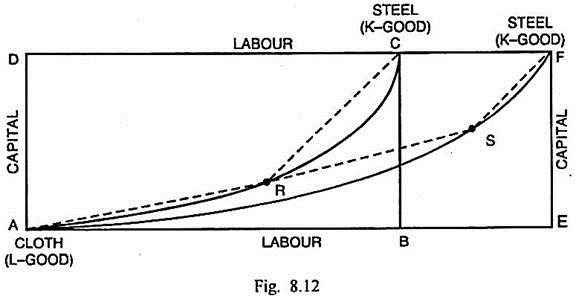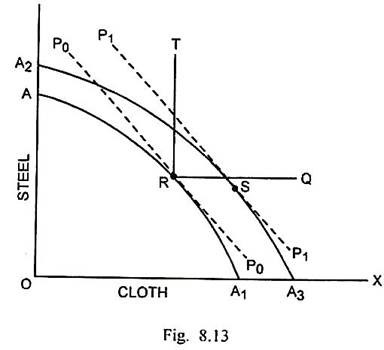In this article we will discuss about the Rybczynski theorem of international trade with its criticisms.
In both Heckscher-Ohlin theory and the factor- price equalisation theory, the assumption was taken that the factor endowments were fixed. T.M. Rybczynski, published a paper in 1955 to investigate the effect of an increase in the quantity of a factor of production upon production, consumption and the terms of trade.
This theorem states that the increase in the supply of one of the factor of production, other factors remaining the same, causes the output of the good using the accumulating factor intensively to increase and the output of the other good to decrease in absolute amount, provided that commodity and factor prices remain unchanged. Suppose in a labour- surplus country, the supply of labour gets increased. It will lead to an increased output of the labour- intensive commodity, say cloth, and reduced output of the capital- intensive commodity, say steel.
Assumptions of the Rybczynski Theorem:
The Rybczynski theorem is based upon the following main assumptions:
ADVERTISEMENTS:
(i) The trade takes place between two countries. The case of only one of the two countries will be discussed here.
(ii) The given country is labour-abundant and capital-scarce.
(ii) This country produces two commodities— cloth and steel.
(iv) The production of these commodities requires two factors—labour and capital.
ADVERTISEMENTS:
(v) Capital and labour are perfectly mobile, perfectly divisible and substitutable in some degree.
(vi) Cloth is labour-intensive good and steel is a capital-intensive good.
(vii) There are the conditions of perfect competition in the product and factor markets.
(viii) The production functions related to both the commodities are homogenous of the first degree. That implies constant returns to scale in production.
ADVERTISEMENTS:
(ix) The factor and commodity prices are constant.
(x) The supply of the factor labour expands while that of capital remains the same.
It is now clear that Rybczynki makes departure from H-O theorem and factor-price equalisation theorem in respect of his abandoning the assumption of fixed factor supplies. He discusses the effect of an increased supply of the factor in which the country is abundant upon production, factor and commodity prices and the terms of trade. His theorem is explained through Fig. 8.12.
ABCD is the Edgeworth box concerning the given country. It shows that this country is labour- abundant and capital-scarce. A is the origin of the commodity cloth which is labour- intensive (L-good). C is the origin for the good steel which is capital- intensive (K-good). AC is the non-linear contract curve sagging downwards. The production takes place at R. The K-L ratio in cloth is measured by the slope of the line AR and K-L ratio in steel is measured by the slope of the line RC.
It is now supposed that the supply of labour is increased by BE, capital stock remaining the same, so that the new box diagram is AEFD. Now A and F are the points of origin for the goods cloth and steel respectively. AF is the non-linear contract curve. A is the origin for the L-good cloth and F is the origin for K-good steel. Production, in this case, takes place at S. The K-L ratio in cloth is measured by the slope of the line AS and the K-L ratio in steel is measured by the slope of the line SF.
The factor-intensity in the two commodities remains unchanged at the points R and S. Since R and S lie on the same straight line AS, the K-L ratio in cloth remains unchanged. On the other hand, the line RC is parallel to SF. Since the slope of RC and SF are equal, there is no change also in the K-L ratio in the capital-intensive commodity steel.
When the factor- intensity in both the commodities remains the same, there will be no change in the prices of the two factors. It shows that the Rybczynaski theorem refutes the possibility of factor price equalisation. As the increase in the supply of labour in the labour-abundant country and increase in capital stock in the capital-abundant country leaves the prices of two factors unchanged, there can be no equalisation in the factor prices.
When there is no change in the prices of the factors of production, the prices of two commodities will also remain the same as before.
ADVERTISEMENTS:
The most significant effect of an increase in the supply of factor will be upon the volume of production. The distance of the point of production equilibrium from origin measures the quantity produced of a commodity. In case of cloth, the original production is measured by the distance AR. Subsequently, it is measured by the distance AS. Since AS is greater than AR, it signifies an increase in the production of cloth after there is an increase in the supply of labour.
In case of steel, the production at R was originally indicated by the distance RC and subsequently it is measured by the distance SF. Since SF is shorter than RC, it follows that the production of K-good steel decreases after there is an expansion in the supply of labour in this country. Thus the conclusion can be drawn that the increased supply of one factor, keeping the other unchanged, will raise in absolute amount the production of good intensive in the increasing factor, while the production of the other good will get reduced in absolute amount.
The above analysis suggests that the commodity prices of the two commodities remain constant. This can happen only if the prices of two factors remain constant. It implies that the capital- labour ratio in the two industries remains constant. But how can all this be possible when the quantity of one of the two factors goes on increasing.
In this connection, it may be stated that increase in the supply of labour will result in the entire additional labour going into the labour-intensive industry. There will also be diversion of labour from the capital- intensive industry (steel). Along with the diversion of labour, some amount of capital will also be diverted from the steel industry to the labour-intensive cloth industry.
ADVERTISEMENTS:
Consequently, the production of cloth expands and that of steel contracts but the K-L ratios in two industries, factor prices and commodity prices still remain unchanged. If the labour force continues to expand indefinitely, the country will soon become completely specialised in the production of cloth.
The constancy of the commodity prices implies that the terms of trade will remain unaffected. However, the equilibrium with constant prices, when supply of one factor has been increasing, is not compatible with general equilibrium. It may be possible if one of the two commodities, particularly the commodity intensive in the other factor (capital) is inferior. But neither of the two commodities— cloth and steel, can be considered inferior.
The general equilibrium in such a situation can be possible only if the price of the commodity intensive in the expanding factor decreases. It means the terms of trade are likely to become worse for the country in which one factor has been expanding. This is explained through Fig. 8.13.
ADVERTISEMENTS:
In Fig. 8.13, the labour-intensive commodity cloth is measured along the horizontal scale and the capital-intensive commodity steel is measured along the vertical scale. The production possibility curve AA1 is derived from the box ABCD shown in Fig. 8.12. The international terms of trade are denoted by the slope of P0P0. The production equilibrium is determined at R.
The expanded supply of labour along with diversion of labour and capital from steel industry to cloth industry gives the new production possibility curve A2A3 derived from Box AEFD in Fig. 8.12. If the prices of two commodities remain the same, the terms of trade line P1P1 is parallel to P0P0. The production equilibrium takes place now at S where P1P1 is tangent to A2A3.
The point S shows a larger production of labour-intensive commodity cloth and reduced output of the capital-intensive commodity steel. This can happen only if steel is an inferior commodity. The expansion in labour force and shift in the production possibility curve to the right imply an increase in national income.
In such a situation, barring the inferior goods, the demand for both the goods must increase. Therefore, the new position of equilibrium must lie on that part of the production possibility curve A2A3 that lies between the lines RQ and RT. The slope of this segment on the curve A2A3 is less steep than the slope of AA1 at R. It implies that the price of cloth will be relatively lower and that of steel is relatively higher. A lower price of exportable commodity cloth and a higher price of importable commodity steel mean that there is deterioration of terms of trade subsequent to an increase in the supply of labour.
About the pattern of consumption, Rybczynski explained that the pattern of consumption may remain unaltered, or change in favour of one good or the other despite the change in the relative prices of the two commodities. If the marginal propensity to consume of the product intensive in the accumulated factor is equal to or greater than the average propensity to consume, the production and the consumption pattern will change in the direction of the product intensive in that factor.
When the marginal propensity to consume falls short of the average propensity to consume, the new production and consumption pattern may still change in favour of the commodity using much of the factor increased, or may remain unchanged or move in the direction of the other good. This depends upon the relative magnitudes of the average and marginal propensities to consume.
ADVERTISEMENTS:
From the above analysis, it is obvious that the Rybczynski theorem has several implications related to production, factor and commodity prices, and terms of trade and consumption pattern. However, its implication related to the factor price equalisation is most clear-cut. When the supply of the abundant factor increases rapidly, the factor price ratio may remain unchanged preventing the equalisation of factor prices among the trading countries.
Criticisms of the Rybczynski Theorem:
E.J. Mishan has raised two major objections against the theorem given by Rybczynski. Firstly, if the increase in the supply of one factor (labour) is accompanied by the increased supply of the other factor (capital), the results suggested by Rybczynski are not likely to follow. Secondly, there is technical difficulty in extending Rybczynski’s two- factor model to a multi-factor system.

